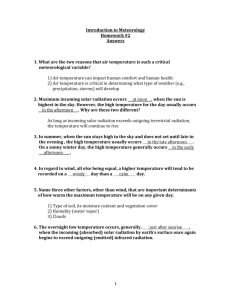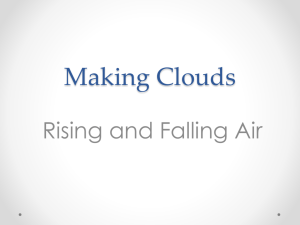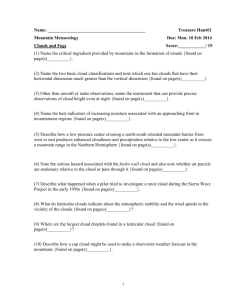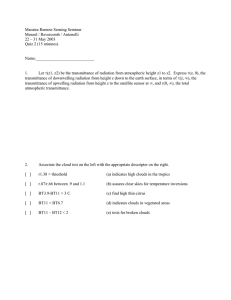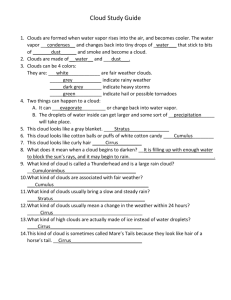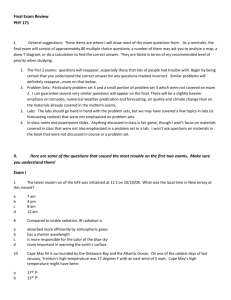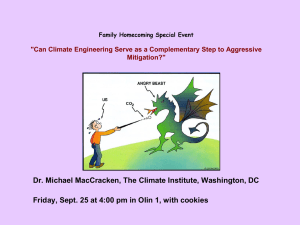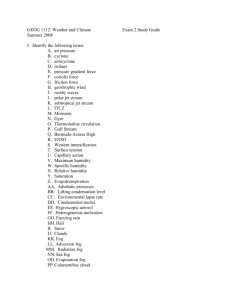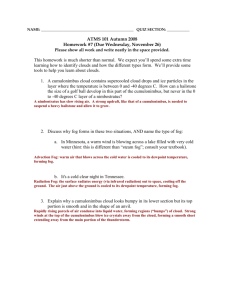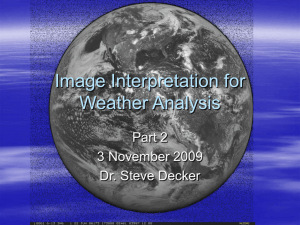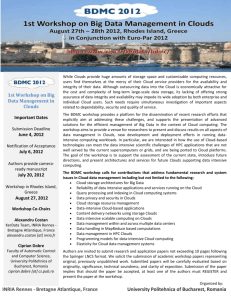Introduction to Meteorology Homework #2 (Chapters 3, 4 and 15
advertisement
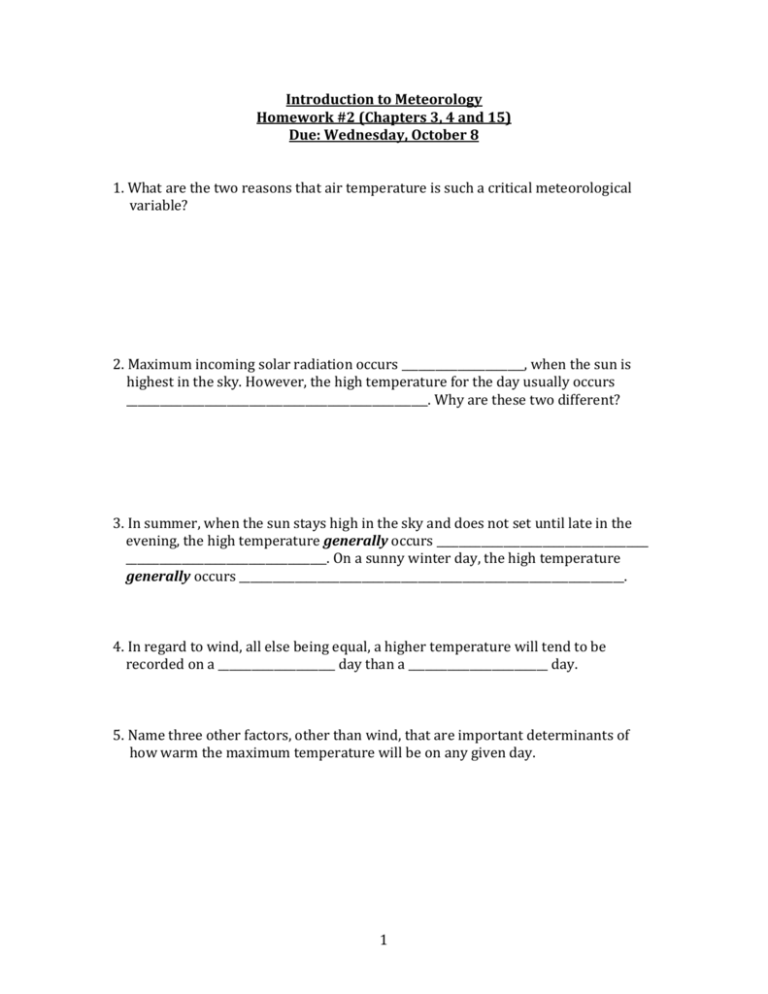
Introduction to Meteorology Homework #2 (Chapters 3, 4 and 15) Due: Wednesday, October 8 1. What are the two reasons that air temperature is such a critical meteorological variable? 2. Maximum incoming solar radiation occurs ______________________, when the sun is highest in the sky. However, the high temperature for the day usually occurs ______________________________________________________. Why are these two different? 3. In summer, when the sun stays high in the sky and does not set until late in the evening, the high temperature generally occurs ______________________________________ ____________________________________. On a sunny winter day, the high temperature generally occurs _____________________________________________________________________. 4. In regard to wind, all else being equal, a higher temperature will tend to be recorded on a _____________________ day than a _________________________ day. 5. Name three other factors, other than wind, that are important determinants of how warm the maximum temperature will be on any given day. 1 6. The overnight low temperature occurs, generally, ____________________________________, when the incoming (absorbed) solar radiation by earth’s surface once again begins to exceed outgoing (emitted) infrared radiation. 7. What are the four primary factors that determine how cold the overnight minimum temperature will be on any given day? 8. The coldest temperatures occur on _________________, __________________, _______________ nights in __________________________. 9. On these types of nights (previous question) an atypical vertical temperature profile develops in which it is coldest near the ground and warmer above. What is this temperature profile called? 10. The coldest air and lowest temperatures overnight are usually found _____________ ____________________________________________________________________________________________. The reason for this is that cold air is _________________________________________ and will drain downhill and settle at the lowest point. 11. What practical relevance does a radiation inversion have in regard to air pollution? 12. a) In regards to clouds, what type of conditions will result in a small daily temperature range? b) Why? 2 13. a) Which city will have a smaller daily temperature range; Atlantic City, NJ or Denver, CO? b) Why? 14. What is the urban heat island effect? 15. a) What is the main determinant of the temperature any given region will have over the course of the year (i.e. climate of a region)? b) What are three other determinants? 16. a) How is heating degree days determined? b) What purpose does calculating heating degree days serve? 17. Do we feel colder on a windy, cold day or on a calm, cold day (wind chill index)? 18. ___________________________________ thermometers are more sensitive and accurate than liquid-in-glass thermometers and have largely replaced them for use in weather stations. 19. In order that an air temperature reading be accurate, it must be recorded _____________________________________________________________. 3 20. What is the major source of water vapor in the atmosphere? 21. What is “vapor pressure (VP)”? 22. a) What is “saturation vapor pressure (SVP)”? b) What atmospheric variable is the sole determinant of SVP? c) Which has a higher SVP, warm air or cold air? 23. Relative humidity is a measure of _____________________________________________________ ____________________________________________________________________________________________. 24. a) What is dew point? b) Why is dew point a better measure of human discomfort than relative humidity? 25. Which is lighter, moist air or dry air? 26. Dew and frost form when the temperature near the ground reaches _______________________________________________________. 4 27. What are the two ways that fog can form? 28. What type of fog forms on clear, calm nights in late fall or winter over land, particularly in valleys? 29. What type of fog is common in San Francisco, London and along the Maine Coast? 30. What is the definition of a cloud? 31. There are four groups of cloud types. Three groups are based upon the height of the clouds base above earth’s surface and the fourth group contains clouds that show _________________________________________________________________________________. 32. What “thin, wispy cloud” is the most common type of high cloud? 33. What type of clouds can create a “halo” around the sun or moon and frequently form well in advance of an advancing mid-latitude cyclone (storm system)? 34. What type of low cloud is dark grey and associated with more or less continuously falling rain or snow (sometimes called a “rain” cloud)? 5 35. What type of cloud, frequently associated with fair weather, appear as puffy, floating cotton with sharp outlines and a flat base? 36. What type of clouds are “thunderstorm” clouds? 37. Why is the sky blue? 38. Why are sunrises and sunsets yellow, orange and red? 39. What type of optical process, which causes twinkling stars, mirages and halos is due to the fact that light changes speed in air of different density, causing it to “bend”? 40. Multiple colorful optical phenomena such as sun dogs and rainbows are caused by what additional optical process that results in a separation of the different colors of the light spectrum? 6
